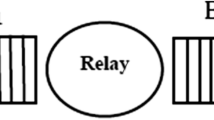Abstract
Network coding is a key technology to improve the spectrum utilization of relay network, however the buffer allocation has not been discussed, and the signalling overhead and the lossy link are often ignored in current researches. In this paper, a practical two-way relay protocol is proposed with the consideration of finite relay buffer, signalling overhead and lossy link. We also construct an analytic model to evaluate the protocol and derive the closed-form expressions of the throughput, queueing delay and overflow probability. Simulation demonstrates that our protocol outperforms the existing transmission strategy, and our analytic model is able to characterise the relay system precisely. Compared with the existing protocol, the throughput of our strategy increases by 14.3 % and the power consumption decreases by 11.3 %. Our mathematical model is useful to configure a suitable buffer size, to gain approximately 16.7 % throughput.







Similar content being viewed by others
References
R. Ahlswede, N. Cai, S.-Y. Li, and R. W. Yeung, “Network information flow,” IEEE Trans. Inform. Theory, vol. 46, no. 4, pp. 1204–1216, 2000.
P. A. Chou, Y. Wu, and K. Jain, “Practical network coding,” in Proc. Allerton Conf. Commun., 2003.
S. Zhang, S. C. Liew, and P. P. Lam, “Hot topic: physical-layer network coding,” in 12th ACM, MobiCom. 2006, pp. 358–365.
C.-H. Liu and F. Xue, “Network coding for two-way relaying: rate region, sum rate and opportunistic scheduling,” in Commun., ICC’08. IEEE Internat. Conf. IEEE, 2008, pp. 1044–1049.
Chou P A, Wu Y. Network coding for the internet and wireless networks [J]. IEEE Signal Processing Magazine, 2007, 24(5): 77.
W. Li, J. Li, and P. Fan, “Network coding for two-way relaying networks over rayleigh fading channels,” IEEE Trans. Veh. Technol., vol. 59, no. 9, pp. 4476–4488, 2010.
Fragouli C, Katabi D, Markopoulou A, et al. Wireless network coding: Opportunities & challenges[C]//Military Communications Conference, MILCOM 2007. IEEE. IEEE, 2007: 1–8.
S. C. Liew, S. Zhang, and L. Lu, “Physical-layer network coding: Tutorial, survey, and beyond,” Phys. Commun., vol. 6, pp. 4–42, 2013.
S. Zhang, S.-C. Liew, and H. Wang, “Synchronization analysis for wireless twrc operated with physical-layer network coding,” Wireless personal communications, vol. 68, no. 3, pp. 637–653, 2013.
A. Ikhlef, D. S. Michalopoulos and R. Schober, “Max-Max Relay Selection for Relays with Buffers,” in IEEE Trans. Wireless Commun, vol. 11, no. 3, pp. 1124–1135, March 2012.
F. Rossetto and D. Lucani, “Systematic design of network coding aware buffering strategies,” in Military Communications Conference, MILCOM 2011, Nov 2011, pp. 316–322.
R. P. Liu, G. Sutton, and I. Collings, “A new queueing model for QoS analysis of IEEE 802.11 DCF with finite buffer and load,” IEEE Trans. Wireless Commun., vol. 9, no. 8, pp. 2664–2675, August 2010.
G. Bianchi, “Performance analysis of IEEE 802.11 distributed coordination functions,” IEEE J. Sel. Areas Commun., vol. 18, no. 3, pp. 535–547, Mar 2000.
I. Krikidis, T. Charalambous, and J. S. Thompson, “Buffer-Aided Relay Selection for Cooperative Diversity Systems without Delay Constraints,” in IEEE Trans. Wireless Commun., vol. 11, no. 5, pp. 1957–1967, May 2012.
W. Chen, K. B. Letaief, and Z. Cao, “Buffer-aware network coding for wireless networks,” IEEE/ACM Trans. Networking, vol. 20, no. 5, pp. 1389–1401, 2012.
V. Jamali, N. Zlatanov, and R. Schober, “Bidirectional buffer-aided relay networks with fixed rate transmission part ii: Delay-constrained case,” IEEE Trans. Wireless Commun., vol. 14, no. 3, pp. 1339–1355, 2015.
C. Hausl and J. Hagenauer, “Iterative Network and Channel Decoding for the Two-Way Relay Channel,” Communications, 2006. ICC ‘06. IEEE International Conference on, Istanbul, 2006, pp. 1568–1573.
Acknowledgments
This work was supported by National Natural Science Foundation of China (No. 51541410) and Natural Science Foundation of Jiangsu Province (No. BK20130199).
Author information
Authors and Affiliations
Corresponding author
Rights and permissions
About this article
Cite this article
Shi, S., Li, S. & Tian, J. Performance Analysis for Practical XOR Two-Way Relay Under Finite Relay Buffer. Int J Wireless Inf Networks 23, 112–121 (2016). https://doi.org/10.1007/s10776-016-0309-0
Received:
Accepted:
Published:
Issue Date:
DOI: https://doi.org/10.1007/s10776-016-0309-0




